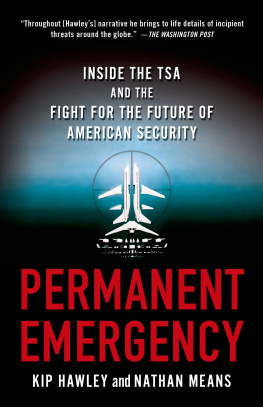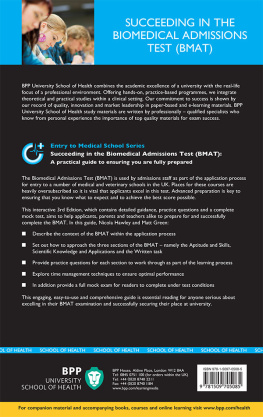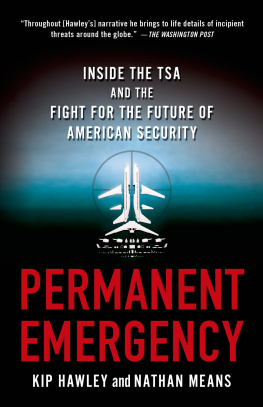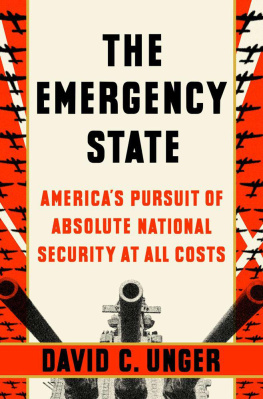Kip Hawley - Permanent Emergency: Inside the TSA and the Fight for the Future of American Security
Here you can read online Kip Hawley - Permanent Emergency: Inside the TSA and the Fight for the Future of American Security full text of the book (entire story) in english for free. Download pdf and epub, get meaning, cover and reviews about this ebook. year: 2012, publisher: St. Martins Press, genre: Detective and thriller. Description of the work, (preface) as well as reviews are available. Best literature library LitArk.com created for fans of good reading and offers a wide selection of genres:
Romance novel
Science fiction
Adventure
Detective
Science
History
Home and family
Prose
Art
Politics
Computer
Non-fiction
Religion
Business
Children
Humor
Choose a favorite category and find really read worthwhile books. Enjoy immersion in the world of imagination, feel the emotions of the characters or learn something new for yourself, make an fascinating discovery.
- Book:Permanent Emergency: Inside the TSA and the Fight for the Future of American Security
- Author:
- Publisher:St. Martins Press
- Genre:
- Year:2012
- Rating:5 / 5
- Favourites:Add to favourites
- Your mark:
- 100
- 1
- 2
- 3
- 4
- 5
Permanent Emergency: Inside the TSA and the Fight for the Future of American Security: summary, description and annotation
We offer to read an annotation, description, summary or preface (depends on what the author of the book "Permanent Emergency: Inside the TSA and the Fight for the Future of American Security" wrote himself). If you haven't found the necessary information about the book — write in the comments, we will try to find it.
Kip Hawley: author's other books
Who wrote Permanent Emergency: Inside the TSA and the Fight for the Future of American Security? Find out the surname, the name of the author of the book and a list of all author's works by series.
Permanent Emergency: Inside the TSA and the Fight for the Future of American Security — read online for free the complete book (whole text) full work
Below is the text of the book, divided by pages. System saving the place of the last page read, allows you to conveniently read the book "Permanent Emergency: Inside the TSA and the Fight for the Future of American Security" online for free, without having to search again every time where you left off. Put a bookmark, and you can go to the page where you finished reading at any time.
Font size:
Interval:
Bookmark:
EMERGENCY
INSIDE THE TSA AND THE FIGHT FOR
THE FUTURE OF AMERICAN SECURITY
KIP HAWLEY AND NATHAN MEANS

The author and publisher have provided this e-book to you for your personal use only. You may not make this e-book publicly available in any way. Copyright infringement is against the law. If you believe the copy of this e-book you are reading infringes on the authors copyright, please notify the publisher at: us.macmillanusa.com/piracy.
For Jan
Kip
For Xan
Nathan
PERMANENT EMERGENCYIS AN INSIDERS LOOK AT THE TSA from its inception after the attacks of 9/11/2001 till the present, told by a few of the people who were there. It is not a memoir or a history of the TSA. Permanent Emergency is intended as a quick read for people who want to better understand the issues that play out in airports every day and counterterrorism in general. I hope it provides enough background and perspective to motivate readers to actively debate our security future.
In order to keep the story line moving, many of the most important players in TSAs history have had their stories and role trimmed in the editorial process. This is especially true of key players like Congress, airlines, airports, surface transportation, the media, and other communities, because we would have had to double the books length to do them justice. I certainly dont forget them and know that, while they never sought recognition for their important roles, I nonetheless regret not being able to share their contributions in these pages. I am deeply grateful to the characters in Permanent Emergency for allowing me to use their true stories, even if they were not always glorious, in an effort to allow the public to see inside the TSA.
Given that time has intervened and that many of the scenes in Permanent Emergency took place without notes being recorded, I have tried to capture as best I could the actions and quotes attributed to the characters. In all cases except those attributed to possible al-Qaeda operatives, my sources are first person participants. All of the major American characters and our European allies are real people with their actual names and true biographical information. While the stories told are accurate, we changed the names and identifying characteristics of some of the ancillary figures out of respect for their privacy.
Regarding sensitive information, I tried to achieve a balance between portraying reality in its technical and operational details so as to give the reader a true look and feel without providing something useful to those who would harm us. To that end, on occasion I have simplified certain processes or omitted details, or presented as a single scene a composite of events that occurred over time. I am indebted to a number of experts at TSA who read the manuscript with an eye toward achieving this balance. Also, the Office of the Director of National Intelligence provided valuable guidance to protect currently sensitive intelligence information.
Throughout my experience at TSA, I heard, you cant make this stuff up and truth is stranger than fiction on a weekly basis. The startling, unrelenting, clear-eyed focus of terror operatives planning viable attacks on civilian transportation playing out daily against a backdrop of the disconcerting public saga that is the TSA is hard to get down on paper. To convey that very real drama, we needed to give the reader a sense of what it was like on the other side, with al-Qaeda.
In my descriptions of particular operatives I have drawn on what is known generally about their trade-craft and used an amalgam of information known about several operatives where necessary. Where information about an operatives activity during a specific period was unknown, I filled in the gaps with my best guess based on consultations with professionals who track that kind of detail. I have used material from the extensive record that exists in think tanks, journalists accounts, personal interviews, evidence used in criminal trials, law enforcement reporting from outside the United States, and the Internet. I did not use information gained exclusively from what I learned in government service, but rather used that experience to sort the credibility of accounts I uncovered elsewhere.
Permanent Emergency gives a realistic depiction of the action even when, for security reasons or lack of specific knowledge, our narrative does not portray literal fact. In other words, where I have lightly fictionalized an event, detail, or process, what is included in the book pales in comparison to what really happened. Truth is truly more startling than fiction and, if anything, Permanent Emergency dampens the urgency, currency, and criticality of our need to stay ahead of the terrorist threat.
ON THE MORNING OF DECEMBER 25, 2009, ABOUT A YEAR AFTER I left the top spot at the Transportation Security Administration, the passengers for Northwest Flight 253 lined up at Amsterdams sleek Schiphol International Airport to be herded, pushed, poked, prodded, and grilled by airport security.
Belts came off, along with jackets, keys, cell phones, PDAs, iPods, and anything else that might trip the walk-through alarm and bring on the annoying wand, the dreaded pat down, or worst of all, the long walk to an interrogation room. Passengers slipped laptops out of their cases. They prayed that the perfumes and medicines and contact solutions they had bagged in plastic would pass inspection. On the far side of the x-ray machines, security personnel dismantled untold hours of careful Christmas wrapping to get a better look at the presents inside. Meanwhile, the plastic bins just in front of the security barriers filled to overflowing with discarded water and soda bottles, innocent boxes of baby formula and Ensure, and the odd bottle of wine purchased just steps earlier in the duty-free shops by passengers who believed the sealed Schiphol security bags were okay to bring on a US-bound flight.
All this was just the tip of the spear. When passengers first booked this flight, their personal information had been checked against the latest no-fly list. Had the combination of name, birth date, and gender created a match, the traveler would have been denied a boarding pass. A second list of selectees were allowed on board only after intense screening that included deep pat downs and series of swabs capable of detecting the presence of explosive material.
Although nothing in that process had set off warning bells, the security barrier that Flight 253s passengers went through was far from the only in-house filter. While passengers queued between ropes, shuffling from turn to turn, Northwest workers and private contractors on hire were studying them for signs of nervousness. Behind the scenes, in the backrooms and corridors of Schiphol (pronounced Skip-ol) Airport, more security personnel were doing random checks on luggage handlers, foodservice workers, mechanics, and anyone elsein-flight personnel and pilots includedwho might have access to the airplanes cabin, bays, hold, or fuel tanks.
Maybe no one in this terrorism-driven day and age ever flies with complete confidence, but as the 290 people aboard Flight 253 began their descent over Canadian airspace, they had every reason to expect they would land on schedule, on Christmas Day in Motor City, without incident. Until, that is, the passenger in window seat 19A reached beneath his blue airline blanket and injected a syringe of liquid acid into a vial of powdered explosive sewn into his underwear, with the intent of blowing himself and his fellow travelers to bits and pieces.
Font size:
Interval:
Bookmark:
Similar books «Permanent Emergency: Inside the TSA and the Fight for the Future of American Security»
Look at similar books to Permanent Emergency: Inside the TSA and the Fight for the Future of American Security. We have selected literature similar in name and meaning in the hope of providing readers with more options to find new, interesting, not yet read works.
Discussion, reviews of the book Permanent Emergency: Inside the TSA and the Fight for the Future of American Security and just readers' own opinions. Leave your comments, write what you think about the work, its meaning or the main characters. Specify what exactly you liked and what you didn't like, and why you think so.








